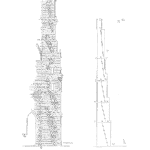
Black’s Equation
Black’s equation for estimating the time to failure due to electromigration is a classic. James Black explored and wrote about electromigration in aluminum metallization within semiconductors since 1969.
He and others have explored other materials used as conductors prone to electromigration. Thus, there are a number of models and constants available to match your particular system.
Let’s take a look at the general equation for a microcircuit conductor after a brief description of the failure mechanisms called electromigration. [Read more…]












